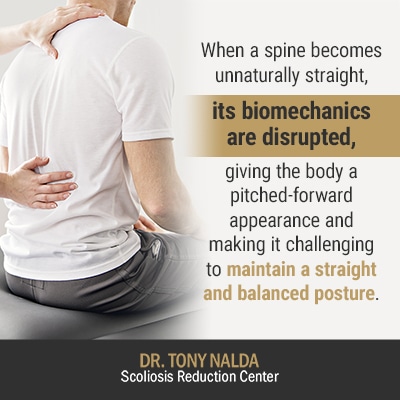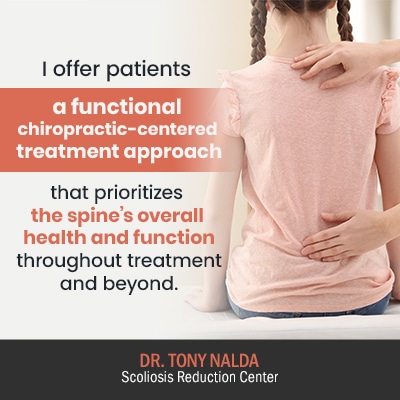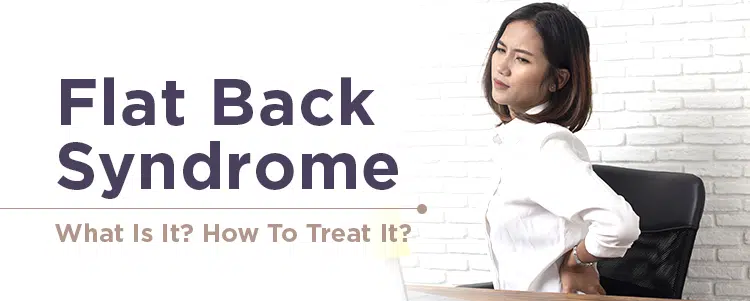The spine’s natural and healthy curves make it stronger, more flexible, and better support body weight evenly. When the spine loses its healthy curves and becomes unnaturally straight, it disrupts its overall biomechanics and affects how it functions. Keep reading to learn about flatback syndrome and how it can be treated effectively.
For the spine to stay aligned, its natural and healthy curves must be maintained and balanced. Flatback syndrome develops when the spine loses its healthy curvatures, becoming excessively straight. The effective treatment combines chiropractic care and therapeutic exercise.
Let’s start our discussion of flatback syndrome by first exploring the spine’s anatomy, including the different curvature types that characterize each spinal section.
Spinal Curvatures
The spine has three main sections: cervical (neck), thoracic (middle/upper back), and lumbar (lower back).
Each of the spinal sections has a distinct curvature type. While natural curvature-degree ranges differ from person to person, balance is achieved when each section’s curvature degree falls within a normal range.
When a spinal curvature falls beyond a normal range by becoming under- or over-pronounced, problems can occur, such as the development of flatback syndrome.
The cervical and lumbar spine feature a curvature type known as lordosis: a backward spinal curvature that appears like a backwards ‘C’ shape.
The thoracic spine features a forward curve known as kyphosis that forms a soft ‘C’ shape.
A healthy range of cervical lordosis is 20 to 40 degrees; normal thoracic kyphosis would fall in the 20 to 40-degree range, while lumbar lordosis has a natural range of 40 to 60 degrees.
What is Flat Back Syndrome?
When the spine loses its lordosis, kyphosis, or both, the spine can become unnaturally straight and cause the development of a spinal condition known as flatback syndrome.

When a spine becomes unnaturally straight, its biomechanics are disrupted, giving the body a pitched-forward appearance and making it challenging to maintain a straight and balanced posture.
So if a person develops flatback syndrome, what types of other symptoms can they expect?
Flat Back Syndrome Symptoms
While every case is different, in addition to the aforementioned postural change of the back stooping forward, people with flat back syndrome can also experience:
- Back-muscle pain
- Mobility issues
- Fatigue
- A sensation of falling forward
- A pronounced stoop that gets worse as the day progresses
- Difficulty standing up straight
It’s not uncommon for people with flatback syndrome to use a cane or walker to help evenly distribute their body weight over the pelvis and legs; this is due to the effects of being off-center.
Fatigue is a natural response to several spinal conditions that interfere with spinal alignment because this causes an uneconomical posture and gait, meaning the body has to expend extra energy in its effort to stay balanced.
Muscle pain is also a common symptom of flatback syndrome and many other spinal conditions, as it’s not just the spine that’s charged with maintaining its healthy and natural curvatures but also the core and back muscles.
When the spine is not optimally aligned, the muscles struggle to provide much-needed support and stabilization. In addition, when the spine loses a natural curvature, it can respond by putting in compensatory curves, leading to more problems.
For example, when the body tries to compensate for its unusually-flat back, it can shift the neck and head forward, known as forward head posture, and this complication of flatback syndrome can cause a new set of issues.
Forward Head Posture
Forward head posture is the body’s way of compensating for its flat back and can cause strained and tight neck and upper-back muscles, not to mention painful shoulders.
If the head shifts forward as little as an inch, the head’s weight increases by approximately 10 pounds, which exposes the neck and shoulders to uneven pressure and excessive strain.
As the muscles that support the neck become imbalanced, the cervical spine loses its much-needed support and stabilization.
So if a person is diagnosed with flatback syndrome, being proactive and searching for the right treatment can avoid complications like forward head posture.
How to Fix Flat Back Syndrome
Here at the Scoliosis Reduction Center®, I’ve spent years treating many spinal conditions, flat back syndrome included.

I offer patients a functional chiropractic-centered treatment approach that prioritizes the spine’s overall health and function throughout treatment and beyond.
I strive to preserve the spine’s function and health with each patient by impacting the condition on a structural level, thus avoiding complications such as developing forward head posture and/or increasing condition severity that can lead to a surgical recommendation.
While no treatment results are ever guaranteed, I work towards impacting flat back syndrome on multiple levels. This is achieved by integrating different forms of treatment, such as condition-specific chiropractic care, in-office therapy, custom-prescribed home exercises, and, when needed, corrective bracing.
Condition-specific chiropractic care can impact the condition on a structural level through gentle and precise chiropractic adjustments/remodeling that works towards repositioning the most-straightened vertebrae (bones of the spine) to restore as much of the healthy spinal curves as possible.
Through condition-specific exercises and physical therapy, I help patients work towards increasing their core strength, so the spine and its surrounding muscles are stronger, allowing for optimal support/stabilization, and this also improves overall posture.
Therapeutic exercise also has the potential to help reverse/fix some of the condition-related muscle imbalances of the lower back: hamstring and abdominal muscles.
While each case is unique, necessitating the customization of effective treatment plans, some common exercises I prescribe for core, buttocks, neck, back, and shoulder strengthening include:
- Chin-ups
- Back extensions
- Chest stretches
- Side-lying leg raises
- Planking
- Hamstring stretches (great for restoring alignment of the lumbar spine)
Particularly for younger patients, corrective bracing can also play a role in treatment by guiding the spine into a corrective position while supporting and stabilizing the spine.
When it comes to forward head posture, chiropractic treatment can also be effectively corrective through the use of gentle and precise vertebral adjustments that work towards reversing joint fixations and engaging important muscles that support the head.
Now that we have defined flat back syndrome explored its symptoms and how to treat it let’s address a condition-related topic regarding pain-reducing sleep positions.
How to Sleep with Flat Back Syndrome
We all know how important sleep is and how disruptive it can be when pain makes it difficult to get a good night’s rest.
For those living with flatback syndrome, sleep is particularly important as we now know that it takes extra energy to maintain balance to compensate for the excessively-straight spine.
In addition, a well-rested body is more responsive to treatment, and healthy sleep habits help create an environment within the body that’s conducive to healing.
While flatback syndrome can cause varying levels of pain, adults tend to find it more painful than young patients. This difference is because adults’ spines are no longer growing, which makes them vulnerable to compression of the spine and its surroundings caused by the loss of one or more of the spine’s healthy curves.
When it comes to the best sleep position for people with flatback syndrome, it’s more about finding a comfortable position that reduces pain and doesn’t expose the spine to any additional uneven pressure.
The best sleep position for those with or without flatback syndrome is flat on the back as this evenly distributes the body’s weight, keeps the spine neutral, aligned, and doesn’t expose it to any additional adverse pressure.
The next-best position is side sleeping, and placing a pillow between the knees can be helpful with maintaining spinal alignment, reducing discomfort, and providing additional support.
Conclusion
When it comes to optimal spinal health and function, an aligned spine with balanced natural and healthy curvatures is key.
Many spinal conditions can cause a person to develop a loss of one or more of the spine’s natural curves, which disrupts spinal biomechanics and function. It means the spine is no longer aligned and balanced as it should be.
When the spine loses its natural inward, outward, or both curvature types, it can become excessively straight, known as flatback syndrome. If left untreated, it can increase in severity and lead to complications such as developing forward head posture.
While every case is different, common symptoms of flatback syndrome include a pitched-forward posture, back pain, muscle pain, changes to gait related to balance issues, fatigue, and difficulty standing up straight.
Here at the Scoliosis Reduction Center®, I can help patients impact the condition on a structural level through targeted chiropractic adjustments that restore some of the spine’s lost natural curvatures. Additional treatments, such as corrective bracing and therapeutic exercise, can further correct and increase core strength to improve spinal support, stabilization, strength, and function.





